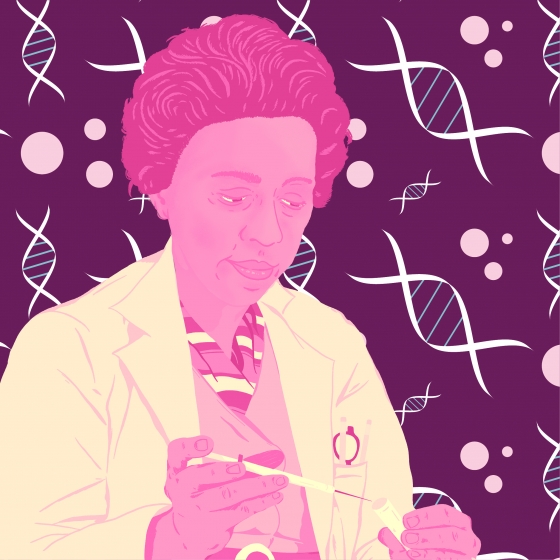
Marie Maynard Daly
Pursing a dream, shaking-up genetics.
It is often that we do not recognise the full impact of a Scientist’s career for years after their initial accomplishments. That is true for biochemist Dr Marie Maynard Daly, whose contributions to genetics and hypertension research still resonate.
Daly was born on 16 April 1921 to Ivan Daly of the British West Indies and Helen Page of Washington DC. The family lived in Queens, New York City while Daly’s father pursued a career in chemistry.1, 2 However, due to financial restraints, Ivan was forced to discontinue his studies and had to find other employment.1, 2
Daly inherited her father’s interest in science and continued to read widely on the subject.1, 2 Inspired by her love of science and with greater access to education, due to the women’s suffrage movement, Daly enrolled in a small, public college, Queens College, New York. At Queens College, Daly completed her bachelor’s degree.1, 2 Daly graduated magna cum laude and was in the top 2.5 per cent of her graduating class from Queens College.1
Following her bachelor’s degree, Daly was awarded a fellowship to study her master’s at New York University, which she completed within a year.1 The involvement of the US in World War II meant many young men were taken from industry in the United States to support the war effort. As such, many traditionally male-dominated career options were now open to women, and Daly was able to enrol in a PhD program at Columbia University.1 Daly worked under the supervision of Mary Letitia Caldwell and, together, they worked to uncover the process of chemical digestion of food in the human body.1 Daly was awarded her PhD after three years of study, becoming the first African American woman to receive a PhD in Chemistry in the United States of America.1, 3, 4
After completing her PhD in 1947, Daly received a grant from the American Cancer Society to research the mechanism of protein synthesis within cells.1 Daly also worked to uncover the role of ribonucleoproteins in protein synthesis, which is an essential component of how organisms produce proteins from genetic material.5 Daly also identified that within the nuclei of cells, purines and pyrimidines, the building blocks of our genetic material, consisted mainly of four base structures.6 These two ground-breaking discoveries are now recognised as essential in contributing to uncovering the structure and function of DNA.7 Daly’s research also aimed to investigate the role of histones, complex protein structures that we now know to be essential for regulating gene expression. Daly developed methods for determining the structure of proteins and provided key insights into the structure of histones. 8, 9
Eventually, Daly left her more genetic orientated research and began to focus on health. Returning to Columbia University, Daly began to research the causes of heart attacks. Daly’s research was some of the first work that investigated the role of diet and smoking in circulatory problems, notably identifying the role of cholesterol in cardiac health.1, 10-12 After a lengthy research career, where her work in science and medicine was recognised with numerous prestigious awards, Daly retired from research in 1986.1 Today, Daly’s research is considered essential, for having far reaching implications for the field, as well as having direct health outcomes to this day.
-
I chose to write about Dr Daly for her ground-breaking scientific contributions and how Daly was able to access education partly due to the efforts of feminist campaigners in the decades before. Likewise, I find it fascinating that an event as horrific as World War II could provide Daly with greater access to traditionally male-orientated career options - a bright side to a tragedy. Daly was a fascinating scientist and deserves recognition amongst the scientific community and the public.
-
Fraser MacLeod is a third year student in the School of Biotechnology and Biomolecular Sciences and is pursuing a PhD in Microbiology.
-
- Morin, K.A., et al., Distinguished African American scientists of the 20th century. 1996: Greenwood Publishing Group.
- Brown, J., Marie Maynard Daly, in African American Women Chemists. 2012, Oxford University Press.
- Griffin, D.H., African American women in science, we speak your names: inspiring our future scientists. Black History Bulletin, 2011. 74(2): p. 20-24.
- U.S. Census Bureau Daily Feature for Feb. 20: Marie Maynard Daly, in U.S. Newswire. 2005: Washington. p. 1.
- Allfrey, V., M.M. Daly, and A. Mirsky, Synthesis of protein in the pancreas: II. The role of ribonucleoprotein in protein synthesis. The Journal of general physiology, 1953. 37(2): p. 157-175.
- Daly, M., V. Allfrey, and A. Mirsky, Purine and pyrimidine contents of some desoxypentose nucleic acids. The Journal of general physiology, 1950. 33(5): p. 497-510.
- Watson, J., The Nobel Prize in Physiology or medicine 1962. 1962: NobelPrize.org.
- Daly, M. and A. Mirsky, Histones with high lysine content. The Journal of general physiology, 1955. 38(3): p. 405.
- Daly, M.M., V. Allfrey, and A. Mirsky, Uptake of glycine-N15 by components of cell nuclei. The Journal of general physiology, 1952. 36(2): p. 173-179.
- Deming, Q., et al., Blood pressure, cholesterol content of serum and tissues and atherogenesis in the rat. Journal of Experimental Medicine, 1958. 107(4): p. 581-598.
- Daly, M., et al., Cholesterol concentration and cholesterol synthesis in aortas of rats with renal hypertension. The Journal of clinical investigation, 1963. 42(10): p. 1606-1612.
- Park, S.S., et al., An animal model of cigarette smoking in beagle dogs: correlative evaluation of effects on pulmonary function, defense, and morphology. American Review of Respiratory Disease, 1977. 115(6): p. 971-979.
Artwork developed by Thomas Bell and Caroline Fox Drinkwater.
